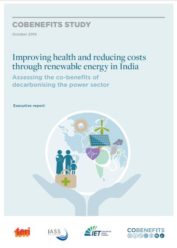 Electricity generation in India is still largely coal-based. In this sense, the power sector is an important contributor to ambient air pollution. At the same time, ambient air pollution has emerged as the second leading health risk factor in India, contributing significantly to India’s burden of cardiovascular diseases, chronic respiratory diseases and lower respiratory tract infections. In this context, this study assesses the impact of ambient air pollution on human health in India. The report quantifies both the health and economic costs associated with PM2.5/PM10 exposure. It aims to assess the range of additional benefits resulting from a low-carbon energy transition in India. The analysis first assesses the impacts of ambient air pollution from all sectors of the Indian economy. It then quantifies the specific impact of the Indian power sector, assessing the health benefits of increased share of renewables in the Indian energy and power sector. The economic savings resulting from improvements in air quality are analysed based on three different energy scenarios.
Electricity generation in India is still largely coal-based. In this sense, the power sector is an important contributor to ambient air pollution. At the same time, ambient air pollution has emerged as the second leading health risk factor in India, contributing significantly to India’s burden of cardiovascular diseases, chronic respiratory diseases and lower respiratory tract infections. In this context, this study assesses the impact of ambient air pollution on human health in India. The report quantifies both the health and economic costs associated with PM2.5/PM10 exposure. It aims to assess the range of additional benefits resulting from a low-carbon energy transition in India. The analysis first assesses the impacts of ambient air pollution from all sectors of the Indian economy. It then quantifies the specific impact of the Indian power sector, assessing the health benefits of increased share of renewables in the Indian energy and power sector. The economic savings resulting from improvements in air quality are analysed based on three different energy scenarios.
Download:
Key policy opportunities:
Policy opportunity 1: India can markedly improve the livelihoods of its citizens by reducing ambient air pollution. In the business-as-usual scenario, during 2020 almost 500,000 people would die prematurely due to exposure to particulate matter (PM10); this number would rise to 600,000 premature deaths during 2030 and 830,000 during 2050. By moving to the NDC PLUS pathway, more than 200,000 premature deaths could be avoided in 2050.
Policy opportunity 2: India can significantly cut economic losses by greening the economy and deploying renewable energy sources. Following the business-as-usual path, economic losses related to health costs could increase from INR 4.6 trillion (USD 64.6 billion ) in 2020 more than two-fold in 2030 and more than ten-fold to INR 47 trillion (USD 660.3 billion) in 2050. However, by following the NDC PLUS pathway, economic losses in 2050 could be reduced by as much as INR 12 trillion (USD 168.6 billion).
Policy opportunity 3: India should consider building and following even more ambitious energy pathways. Even the most far-reaching scenario presented in this report (NDC PLUS) is insufficiently ambitious to prevent a 4.3 % reduction in Indian GDP and an increase in premature deaths in 2050 compared with 2020 levels.
Year of publication: 2019
Editors: David Jacobs, Ayodeji Okunlola, Laura Nagel, Sebastian Helgenberger, Arunima Hakhu — IASS/IET/TERI
Technical implementation: Dr. Anju Goel, Souvik Bhattacharya, Dr. Arindam Dutta, Mani Juneja, Rohanshi Vaid, Dr. Isha Khanna, Seema Kundu, Nimish Singh and Varsha Gupta – The Energy and Resources Institute (TERI)
Suggested citation: IASS/TERI. Improving health and reducing costs through renewable energy in India. Assessing the co-benefits of decarbonising the power sector. Potsdam/New Delhi: IASS/TERI, 2019.
DOI: 10.2312/iass.2019.021
This study is part of a 2019 series of three studies assessing the co-benefits of decarbonising the power sector in India, edited by IASS, IET, TERI and UfU:
